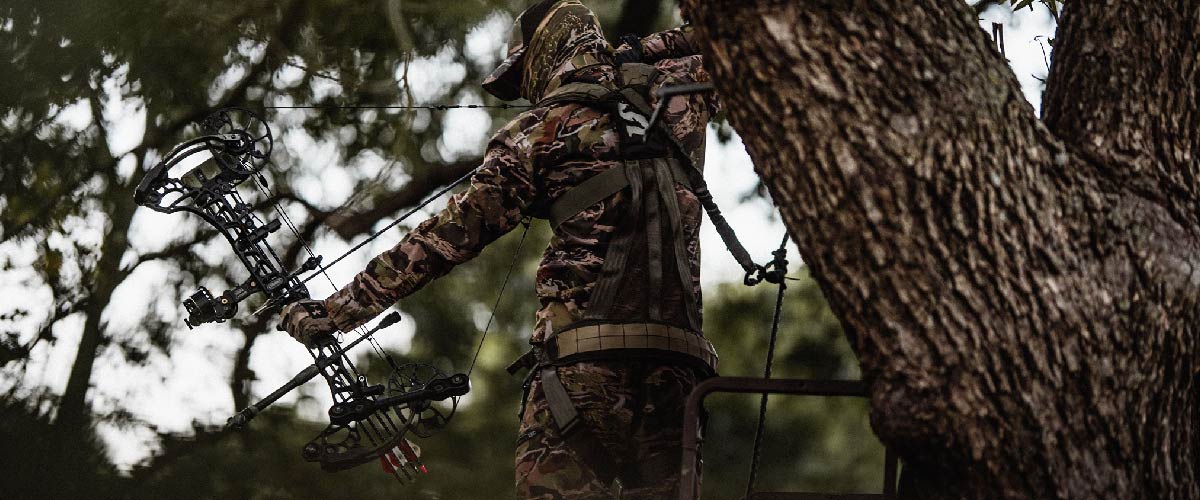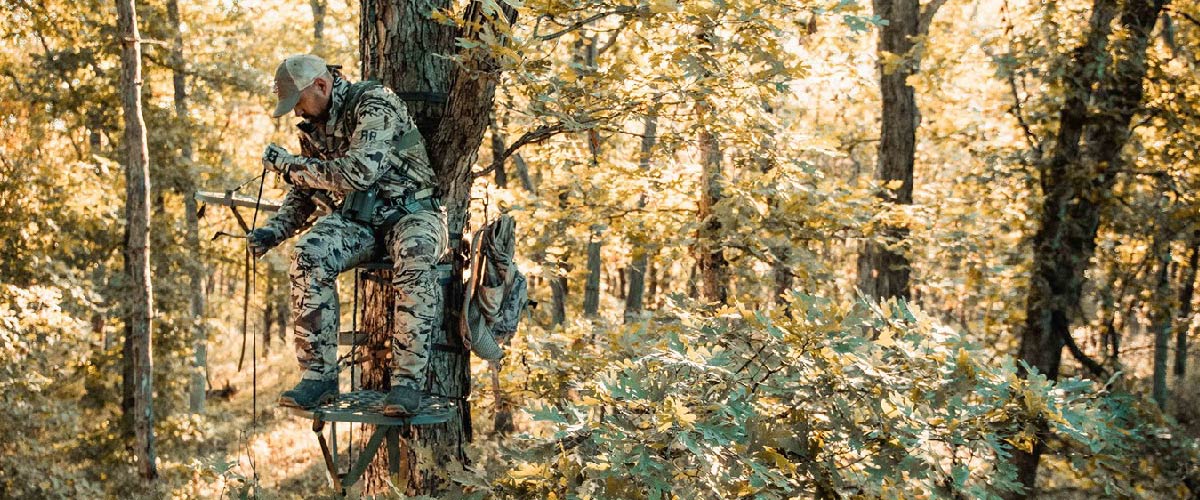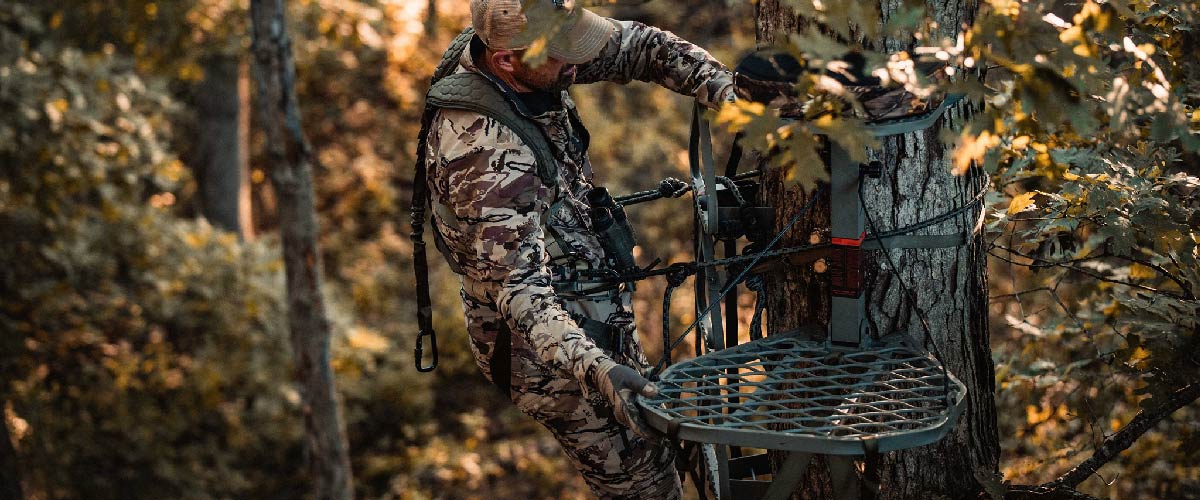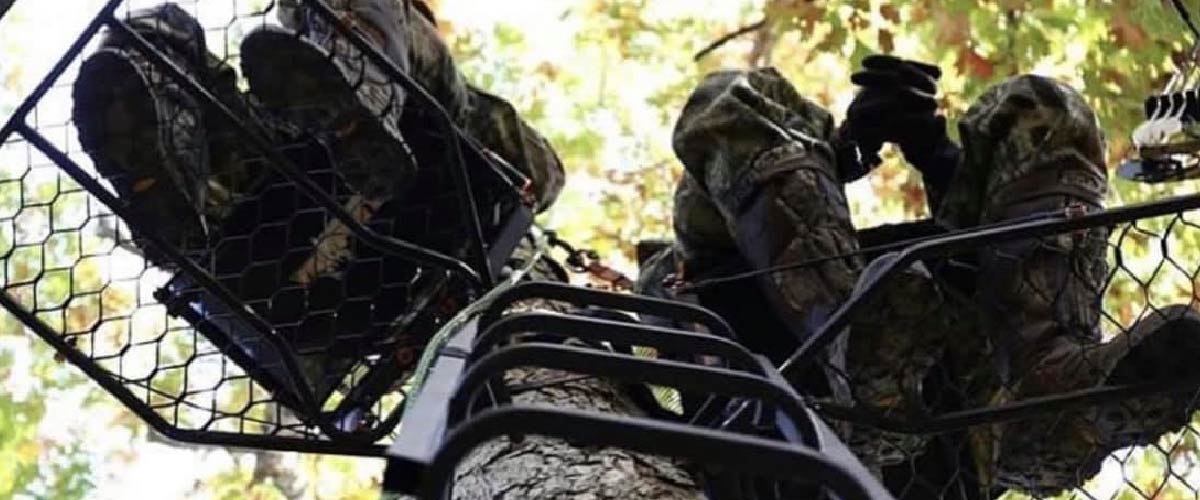How to Select
a Tree Stand for Bowhunting

Tree stands can take your bow hunting to the next level, and you can choose between hang-on stands, ladder stands, and climbing stands. These different types each offer their own unique features that can help you have a wider field of vision and a greater advantage when you’re bowhunting deer or any other type of game.
This guide will take you through the primary considerations of choosing a tree stand, and make sure that you have a solid understanding of what a tree stand should do for you before you spend a dollar.
First, let’s get clear on the three main types of tree stands. The right type will depend on your personal needs and goals when bowhunting, so make sure you have a clear sense of your priorities as you move through this article.
Climbing Stands

A climbing stand is so named because the stand itself helps you to scale the tree. When you put the stand onto the tree, its fulcrum system uses the stand’s weight to put pressure against the tree, keeping the stand in place. The platform and seat on a climbing stand are separated, so you lift weight off one part in order to move the stand higher. This way, you can get up the tree with your stand little by little.
Climbing stands are the most versatile and portable stands. They are usually very light, which is important if you plan to move to multiple locations throughout a long day of bowhunting, or even if you’re doing one setup that’s a decent hike into the woods. You don’t need any other materials in order to get yourself and your stand up into the tree.
Climbing stands are an excellent option for hunters who move around to different spots, or who cannot leave their stands up throughout the season for any reason.
Hang-On Stands

Hang-on stands are more stable than climbing stands, while still being fairly portable. These light, collapsible stands are not too difficult to carry throughout the woods. However, these stands do attach directly to the tree. You use strong brackets or straps in order to attach the stand, meaning you can also leave them up if you wish to.
Hang-on stands are more difficult to get into than climbing stands, since the stand itself can’t help you scale the tree. Many hunters use climbing sticks. Climbing sticks must be attached to the tree up to the point of the stand. This means that in addition to the hang-on stand, you are carrying climbing sticks with you to your destination.
If you want the option to leave your stand up, but you don’t have a particular spot fully chosen yet, hang-on stands are a great option. They are a little more secure than climbing stands, while still being versatile.
Ladder Stands

If you are not worried about the ability to carry your stand with you, ladder stands will offer the greatest stability. These stands are designed to be left in the same location through the entire season, if not across multiple seasons. These are durable stands that are sure to keep you in your position, and offer more room for your stance while bowhunting.
Ladder stands are significantly heavier than the other options, so they are quite difficult to maneuver. In fact, you might need a partner in order to set up the ladder stand in the first place. Often, one person can hold the ladder in place, while the other lifts it and attaches it to the tree. It’s possible that you will be able to install a lighter ladder stand by yourself, but you will need to find a way to hold the ladder in position, such as bending rebar over the bottom rung.
If you have all-season access to a particular spot and you are confident that it will yield the game you want, a ladder stand is a great fit for you. Plus, then you don’t have to worry about finding new locations or setting up your stand. Just have a plan in case your buddy wants to try a new spot somewhere else!
Choosing a Type
As we’ve seen, the best type of tree stand for bowhunting depends on your individual situation. In general, climbing stands are widely used for their versatility and portability. The ability to move between positions easily means you can hunt a longer season as deer and other game movement patterns change. Climbing stands allow you to adapt your strategy as needed, and find the ideal height based on the terrain you are working in.
That said, there is no “right” or “wrong” type of tree stand for bowhunting. The choice is yours based on your intentions throughout the season, and each of these will give you an advantage and greater visibility for your next bowhunting season.
Height
The purpose of a tree stand is to give you better visibility thanks to its height, so choosing the height is an important part of the process. You should set your stand up so that you have a good view of your surroundings, without going so high that tree cover blocks your view.
Your stand should also be high enough that your scent goes over the heads of the deer instead of being carried directly to them. This depends on the wind patterns in your area. If you are looking to set up a stand that is sure to carry your scent away, you can check the wind patterns with a kite.
In general, you will likely want to set your stand up at a height of 16-20 feet. Most ladder stands are made to fit in this range. When you’re bowhunting, you will need to be even higher up than when you are rifle hunting, so that deer don’t see you draw the bow. This means going up to 20 or even 22 feet if possible.
Comfort
Comfort is a major factor in choosing the right tree stand, as you will be spending a significant amount of time in your stand. The most important factor determining comfort is the seat on the stand. Check out whether it has a seatback, and whether the seat is padded or woven mesh. The padded seats will be softer, but you’ll get more support from the mesh.
You also want to pay attention to the size of the seat relative to your size. A larger seat and platform gives you more room to stretch out and shift around.
Many stands also come with additional comfort features that you should analyze. They may come with footrests, armrests, or bow holders. Each of these will make a difference over the course of several hours in your stand.
Portability
We’ve already discussed how choosing a type of tree stand will greatly impact its portability. But size and weight matter too, even within the type that you choose. Make sure you take note of a stand’s size and weight, and whether it is collapsible. Some stands are bulky and difficult to carry, while others will fold down flat. If you are going to be carrying the stand across long distances or over a long period of time, you’ll want to opt for lighter stands that are easier to carry.
Safety Features
Safety harnesses and straps are absolutely essential for setting up your tree stand. Most stands come with this features, but if yours doesn’t for some reason, be sure to include separate purchase of a safety harness and strap in your budget.
Different stands may also come with other safety features, such as fall arrest systems that can keep your stand from falling from the tree.
Noise
Check out what features your stand has that keeps it quiet. A large metal object can make a lot of unwanted noise in the woods, so you want to find out how your stand will combat this and allow you to be stealthy when you need to.
Many stands have sound deadening technology worked into their designs. Stands with fewer moving parts are also likely to make less noise than stands with a lot of moving parts. If you are setting up a ladder stand, you’ll also want to make sure the ladder is as sturdy as possible so that it will not make noise as you step onto it.
Bonus: Expert Tips!
Now you’re ready to check out the many options for tree stands, and get started with this new type of bow hunting! Before you set out, we want to leave you with a few quality tips.
First, pick the right tree. This is the most important factor in a successful bowhunt. You need the tree to provide you cover, while still having space for you to shoot. You need to be able to see long distances, without being blocked by the tree itself. Separate from what stand you use, you’ll need to invest real time in choosing the right tree.
Then, make sure that your gear is always accessible in the stand. You never know when a deer is going to appear as you’re dozing off, and you don’t want to have to fumble to get your gear. Always be ready to draw and shoot smoothly without scaring the deer away. Keeping organized could mean the difference between a trophy and going home empty-handed.
Finally, make sure to maintain your tree stand. Before each season, check that each of your stand’s many parts is in good condition, especially the safety features. In a climbing stand, check that the teeth and fulcrum mechanism are keeping the stand close to the tree. In a hang-on stand, check the brackets and straps. In a ladder stand, make sure the bolts are keeping everything tightly together, and that the ladder is not showing any wear.